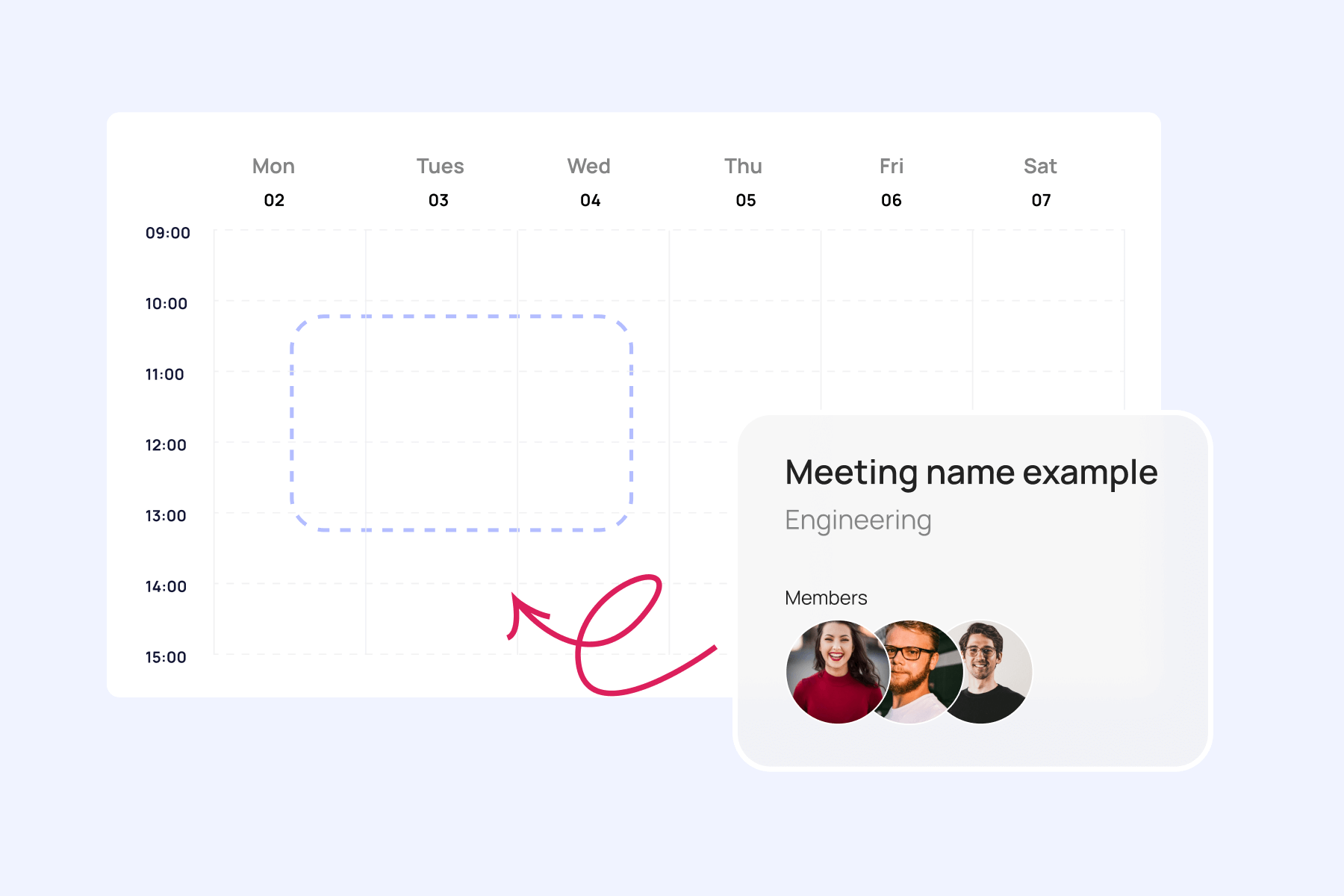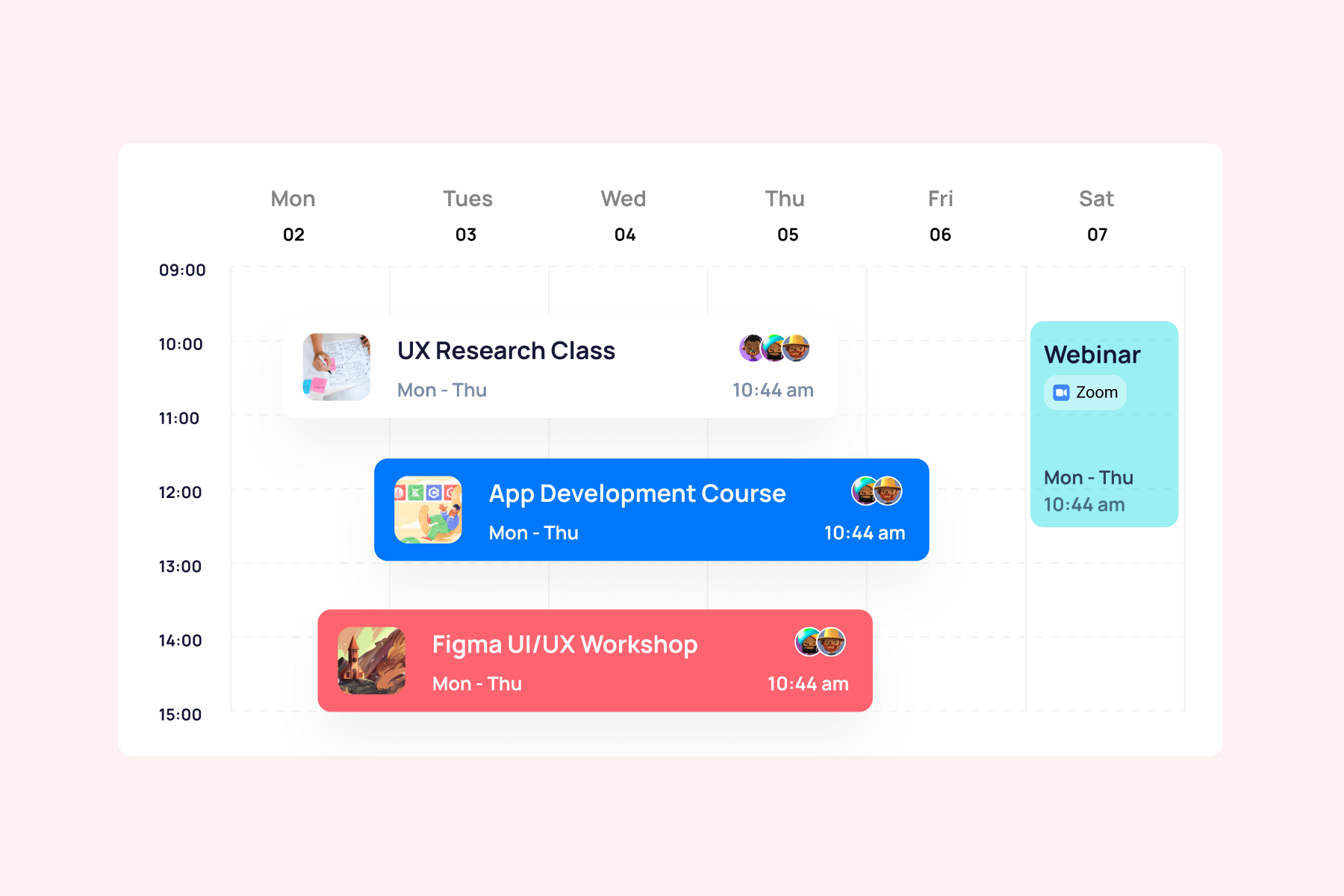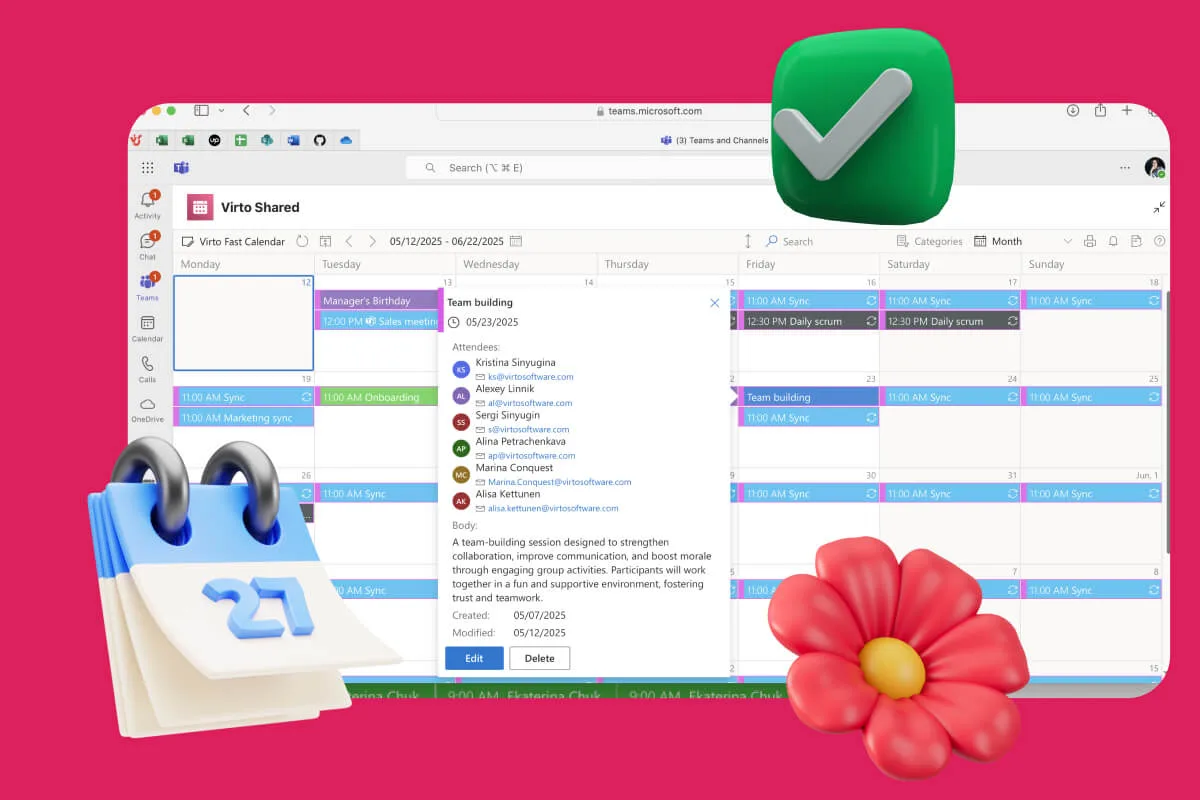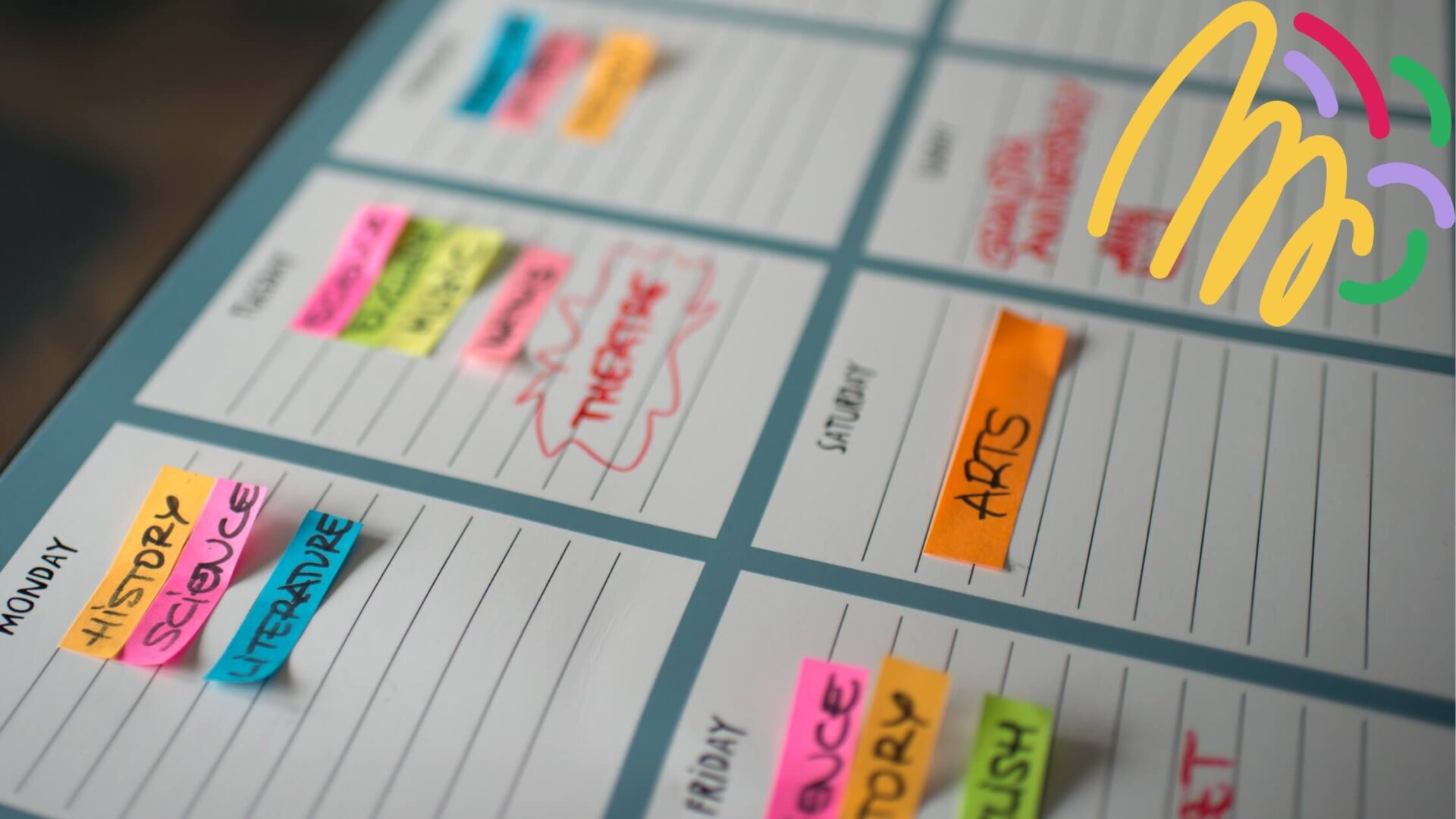Think of material scheduling as your project’s GPS system. Just as you wouldn’t drive across the country without mapping your route, you shouldn’t launch a project without planning when and where your materials need to show up. A material schedule is essentially a detailed roadmap that tracks every component, supply, and resource your project needs, along with precise timing for when each item should arrive.
Why does this matter so much in project management? Because materials are the building blocks of execution. Without them, even the most talented team becomes idle. With too many arriving too early, you’re paying for storage and tying up cash flow. Get the timing wrong, and you’re either scrambling to expedite orders or watching your team stand around waiting.
This planning approach spans industries because the fundamental challenge remains the same everywhere. Construction teams need rebar delivered before concrete pours, not after. Manufacturing plants require raw materials to flow steadily into production lines. Logistics operations depend on inventory moving through distribution centers without creating bottlenecks. Whether you’re building skyscrapers, assembling electronics, or managing supply chains, the principle holds: synchronized material flow drives project success.
Here’s what happens when material planning goes sideways. Projects stall because critical components are stuck in transit. Budgets explode from rush orders and premium shipping costs. Teams lose momentum switching between tasks while waiting for supplies. Quality suffers when substitutions become necessary. Storage costs mount when materials arrive weeks ahead of schedule.
But when you get material scheduling right, projects flow smoothly. Teams maintain their rhythm because everything they need arrives when they need it. Budgets stay on track through strategic procurement timing. Cash flow improves since you’re not paying for materials sitting in warehouses. Quality remains consistent because the right materials arrive in proper condition.
This guide will walk you through building material schedules that actually work. We’ll start by exploring what makes a material schedule effective and why this planning tool has become essential for project success. Then we’ll dive into the practical steps for creating schedules that account for supplier lead times, project dependencies, and the inevitable surprises that arise. Finally, we’ll examine modern tools and techniques that can automate much of this work, giving you better accuracy with less manual effort and helping you stay ahead of potential problems before they derail your project.
What Is a Material Schedule, and Why Is It Needed?
This section will break down the fundamentals of material scheduling by examining what these schedules actually are and exploring their practical applications across different industries. We’ll look at how a well-designed materials schedule functions as more than just a list of supplies—it’s a strategic management tool that can make or break project success. Then we’ll examine real-world examples from construction, manufacturing, and logistics to show how material scheduling adapts to different operational challenges.
What is the material schedule?
A material schedule is a structured document or digital tool that contains a comprehensive list of all required materials, their specific quantities, planned delivery dates, intended use dates, and detailed information about suppliers and delivery conditions. Think of it as your project’s supply chain blueprint—it maps out not just what you need, but when you need it, where it’s coming from, and how it fits into your overall timeline.
This schedule integrates directly into your broader project and resource management strategy. Rather than operating in isolation, it works alongside your project timeline, budget planning, and resource allocation to create a coordinated approach to supply management. The goal is straightforward: eliminate supply chain disruptions, optimize logistics costs, and ensure materials flow smoothly through your project.
The impact of proper material scheduling extends across three critical project dimensions. Project timing stays on track because materials arrive exactly when needed, preventing delays and maintaining momentum. Budget control improves through strategic procurement timing and bulk purchasing opportunities. Quality standards remain consistent because you’re not forced into last-minute substitutions or rushed procurement decisions.
Primary purpose
The fundamental purpose of material scheduling is ensuring accurate and timely material delivery to your project site or production facility. This means every project stage receives the resources it needs within the planned timeframe, maintaining the project’s forward momentum without interruption.
Why is material scheduling important?
Material scheduling isn’t administrative busywork—it’s a management tool that directly impacts project success. Here’s how it works in practice:
- Resource and personnel optimization: A good material schedule ensures uniform loading of both resources and personnel. Instead of overwhelming your team with too many materials at once or leaving them idle while waiting for supplies, you create steady, manageable workflows that keep everyone productive.
- Procurement organization: The schedule facilitates timely material procurement by providing clear visibility into upcoming needs. Your purchasing team can negotiate better terms, secure quantity discounts, and avoid the premium costs associated with rush orders.
- Cross-department coordination: Material schedules help coordinate actions across different departments—from design teams who specify requirements to logistics teams who handle delivery. Everyone works from the same information, reducing miscommunication and conflicting priorities.
- Work schedule synchronization: The schedule allows you to synchronize material availability with your work schedule. This is particularly crucial in construction projects where specific materials must arrive before certain tasks can begin.
- Logistics control: You gain better control over delivery logistics, including storage requirements, handling equipment needs, and site access coordination. This prevents situations where materials arrive but can’t be properly received or stored.
- Work schedule foundation: In construction projects especially, the material schedule often serves as the foundation for the overall work schedule. You can’t pour concrete without having concrete delivered, and you can’t install fixtures without having them on site.
- Cost control and deviation response: The schedule enables quick response to cost deviations, reducing the risk of both shortages and expensive surpluses. When changes occur, you can immediately assess their impact on material needs and adjust accordingly.
- Financial planning support: Material schedules support staged purchasing according to your budget and cash flow requirements. Instead of tying up capital in materials that won’t be used for months, you can time purchases to align with project phases and payment schedules.
Consequences of poor material scheduling
When material scheduling fails or gets overlooked, the consequences ripple through your entire project:
- Timeline disruption: Delays and downtime become inevitable when materials arrive late or not at all. Teams lose momentum, and catching up becomes increasingly difficult as delays compound.
- Cost escalation: Project costs spiral upward due to urgent purchases at premium prices, expedited shipping costs, and the inefficiencies of chaotic procurement. Emergency purchasing rarely comes with volume discounts or favorable terms.
- Quality compromise: Quality issues emerge when you’re forced to substitute necessary materials with whatever happens to be available. These compromises often create problems that only surface later in the project.
- Operational confusion: Interaction between purchasing, logistics, warehouse, and contractor departments becomes unclear and uncoordinated. Without a shared understanding of material requirements and timing, departments work against each other rather than together.
Use cases
Material scheduling adapts to different industries’ unique challenges while maintaining its core function of coordinating supply and demand. Here’s how it works across various sectors:
Material schedule in construction
In construction, material scheduling becomes especially complex because of the sequential nature of building processes and external factors like weather conditions. The schedule helps accurately calculate which materials are needed on specific days for particular construction stages.
For example, you need concrete delivered on the exact day it will be poured—not a week early when it might deteriorate, and definitely not a day late when crews are standing idle. Similarly, reinforcement steel must arrive before concrete pouring, roofing materials need to be on site before roofing crews begin work, and finishing materials should arrive when interior work starts.
This advance planning allows construction teams to negotiate better terms with suppliers, secure materials during peak demand periods, and prevent costly delays. The schedule must account for supplier logistics capabilities, weather windows that affect both delivery and material use, and the coordination requirements of multiple construction teams working in sequence.
Material schedule in manufacturing
In manufacturing environments, material scheduling synchronizes component delivery with production cycles. This becomes particularly important in assembly-line operations where missing even one component can shut down entire production runs.
Consider household appliance manufacturing: the production schedule requires motors, control panels, fasteners, and electronic components to arrive in precise quantities at specific times. The material schedule ensures these components flow steadily into production without creating bottlenecks or requiring expensive expedited deliveries.
Manufacturing schedules often integrate with just-in-time delivery systems, reducing inventory carrying costs while maintaining production continuity. The schedule helps balance the competing demands of minimizing inventory investment and ensuring production never stops due to material shortages.
Material schedule in logistics and warehousing
For warehouse operations, material scheduling focuses on inventory management: planning timely replenishment while reducing surplus inventory and associated storage costs. The schedule helps maintain optimal stock levels that meet customer demand without tying up excessive capital in inventory.
In eCommerce logistics, material scheduling becomes even more dynamic. The schedule must account for promotional campaigns that spike demand for certain products, seasonal fluctuations that affect buying patterns, and the need to position inventory close to customers for fast delivery. This requires coordinating with suppliers to ensure adequate stock arrives before peak demand periods while avoiding overstock situations that create storage cost burdens.
Stages and Structure of the Schedule of Materials
Building an effective material schedule requires understanding both its fundamental structure and the systematic process for creating it. This section will walk you through the essential components that make up any material schedule, regardless of your industry or project type. We’ll then explore the step-by-step process for developing a schedule that actually works—one that integrates seamlessly with your project management approach and provides the detailed information your team needs to execute successfully.
Structure of the materials schedule
The structure of material schedules varies depending on your industry and project complexity, but certain core elements appear in almost every effective schedule. These fundamental fields provide the information foundation that makes material coordination possible.
Material name
This field requires the exact, specific name of each material—not generic descriptions. Instead of writing “cement,” specify “cement M500.” Rather than “drywall,” use “gypsum board 12.5 mm.” Instead of “metal profile,” specify “aluminum profile 25×25.”
This precision matters because different material specifications often have different suppliers, lead times, and costs. Using official or company-accepted naming conventions ensures everyone on your team refers to the same materials and eliminates confusion during procurement and delivery.
Unit of measurement
Every material needs a clear unit of measurement: kilograms, cubic meters, running meters, pieces, or whatever unit makes sense for that specific material. This standardization enables accurate volume calculations and logistics planning.
Without consistent units, you can’t properly calculate storage space requirements, truck capacity needs, or handling equipment specifications. The unit of measurement also affects how suppliers quote prices and how your team tracks consumption during the project.
Required quantity
This field captures the total amount of material your project needs. For complex or long-duration projects, you might break quantities down by stages or time periods—showing how much you need each week or month rather than just the total project requirement.
Stage-based quantity planning helps with cash flow management and storage logistics. Instead of ordering everything at once, you can coordinate deliveries with actual consumption patterns.
Planned delivery and use date
Two dates matter here: when the material should be delivered to your site or warehouse, and when you plan to use it. The delivery date ensures materials arrive when you need them. The use date helps you avoid early deliveries that tie up storage space and working capital.
Getting these dates right requires balancing multiple factors: you want materials available when work begins, but not so early that they create storage problems or deteriorate while waiting to be used.
Source or supplier
This field identifies the company or contact person responsible for delivering each material. Sometimes you’ll add contract details, payment terms, or specific delivery instructions.
Having supplier information readily available in your schedule speeds up communication when changes occur. If you need to adjust quantities or timing, you know exactly who to contact for each material.
Notes
The notes column captures additional information that doesn’t fit elsewhere but affects how you handle the material. Common examples include:
- Storage requirements like “dry storage required” or “temperature controlled”
- Transportation requirements such as “do not stack” or “ship vertically”
- Certification needs like “requires lab testing” or “needs compliance documentation”
- Handling instructions like “requires crane for unloading” or “fragile – handle with care”
This information prevents problems during delivery and ensures materials maintain their quality from arrival through use.
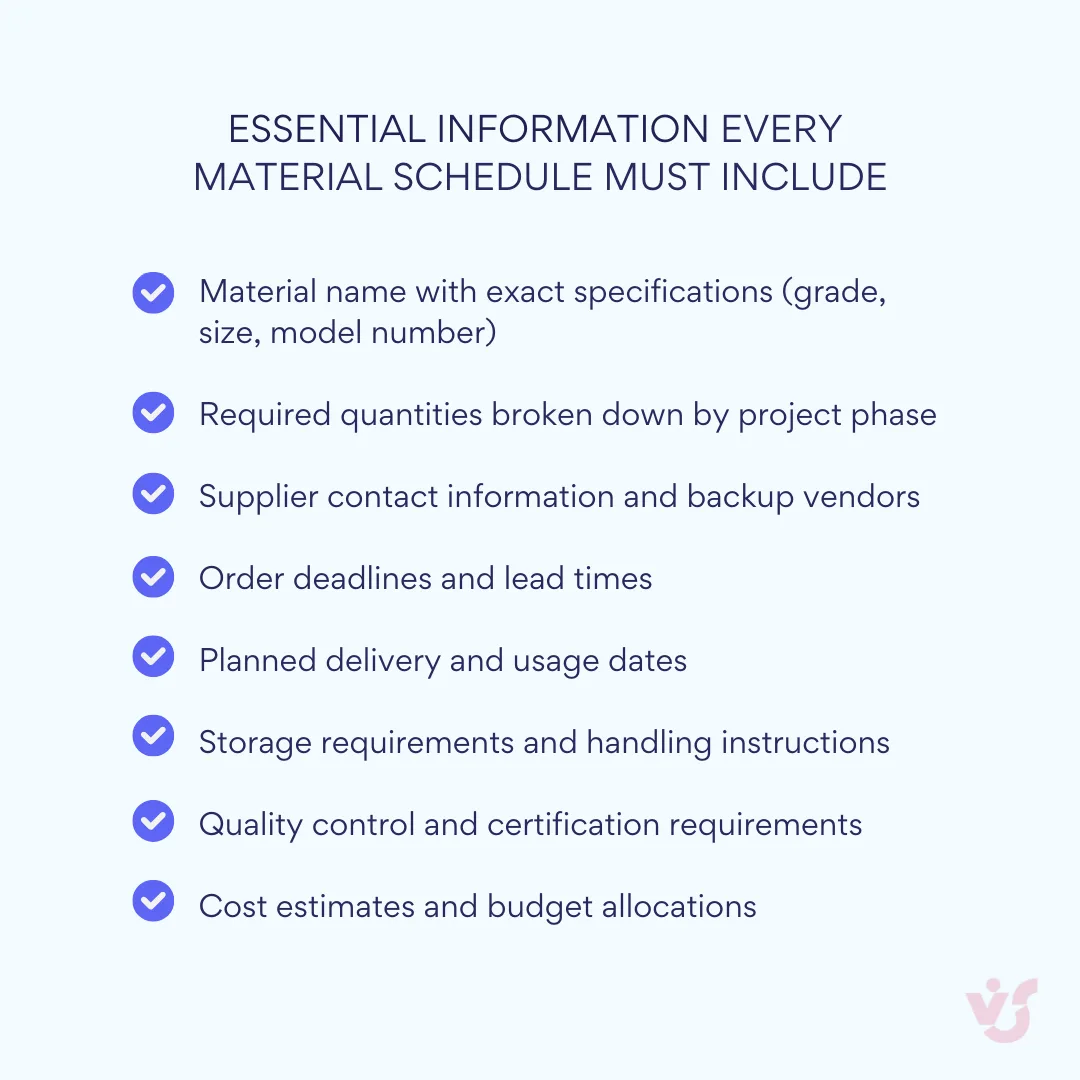
How to Create a Schedule of Materials
Creating an effective material schedule follows a systematic process that integrates with your overall project management approach. This isn’t a one-time activity—it’s an ongoing process that evolves as your project develops.
Here’s how to make a material schedule:
Step 1: Gather requirements from the project team
Start by collecting detailed information from everyone who knows what materials the project needs. This includes architects who specify building materials, engineers who determine structural requirements, technologists who understand production needs, and project managers who coordinate overall resource requirements.
This step determines what materials you’ll need, in what quantities, and at which project stages. Don’t rely on assumptions or outdated information—get current, detailed specifications from the people responsible for each aspect of your project.
Step 2: Coordinate deadlines with production/site
Take your material requirements and compare them against your production schedule or construction timeline. Ensure delivery dates align with realistic project stages and work sequences.
This coordination prevents situations where materials arrive before you’re ready to use them or show up after teams are standing idle waiting for supplies. The goal is synchronizing material availability with actual work progression.
Step 3: Forecasting needs
Look beyond immediate requirements to anticipate factors that might affect material availability or costs. Consider seasonal variations that affect supply or demand, potential market delays during peak periods, and price fluctuations that might influence your procurement timing.
For long-term projects, divide deliveries into logical stages rather than trying to get everything at once. This approach improves cash flow, reduces storage requirements, and provides flexibility to adjust quantities as the project progresses.
Step 4: Consider buffers and risks
Build appropriate safety margins into your schedule. Include buffer stock—typically 5-10% extra—to account for material losses, defects, or unexpected usage increases.
Also build in buffer dates, especially for materials with long lead times or limited availability. If a specialized component typically takes eight weeks to procure, plan for ten weeks to accommodate potential delays.
Step 5: Using templates or software
Create your schedule using whatever tools work best for your team and project complexity. Simple projects might work fine with Excel templates, while complex operations may require specialized project management software.
The key is ensuring your schedule remains accessible to all project participants and can be updated regularly as conditions change. Everyone who needs material information should be able to access current data, and you should be able to modify the schedule quickly when requirements shift.
Material Schedule Templates
Rather than building material schedules from scratch every time, smart project managers use templates to streamline the process and ensure consistency across projects. This section explores how ready-made templates can accelerate your planning while reducing errors, and shows you exactly what elements to include in your own templates. We’ll also cover where to find quality templates and how to adapt them for different project types, plus provide three practical examples you can start using immediately.
👉What is the supply schedule of materials? A supply schedule of materials is essentially the same as a material schedule—it’s a comprehensive plan that outlines when specific materials will be procured and delivered throughout a project timeline. The term “supply schedule” emphasizes the procurement and delivery logistics aspect, focusing on coordinating with suppliers to ensure materials flow smoothly from vendors to the project site. It includes supplier lead times, ordering deadlines, delivery windows, and inventory management to maintain continuous material availability without overstocking. This schedule helps organizations optimize their supply chain by balancing just-in-time delivery with buffer stock to prevent shortages. The supply schedule serves as the backbone for coordinating purchasing decisions, warehouse management, and production or construction activities.
What is a material schedule template?
A materials schedule template is a ready-made table or digital format containing predefined fields and structure where you can insert data for your specific project. Think of it as a blueprint that provides the framework while you fill in the project-specific details.
Templates offer several key advantages for material planning. They speed up document preparation by eliminating the need to design the structure each time you start a new project. They standardize your approach to planning, ensuring all projects follow the same systematic process and capture the same essential information. Most importantly, templates help avoid errors by providing built-in prompts for all necessary information and maintaining consistency across different team members and project phases.
Essential template elements
Every effective material schedule template should include these core components:
Project identification: Include fields for project name and facility information so each schedule clearly identifies which project it belongs to.
Project stage specification: Add a field for the specific project stage, such as “foundation preparation,” “structural installation,” or “finishing work.” This helps organize materials by construction phase or production cycle.
Main data table: The heart of your template should be a structured table containing these essential fields:
- Material name for specific identification
- Unit of measurement for accurate quantity tracking
- Quantity requirements for procurement planning
- Delivery and use dates for timing coordination
- Supplier information for communication and logistics
- Notes section for special requirements or conditions
Status tracking area: Include a dedicated block for comments and status updates where team members can record changes, delivery confirmations, or issues that arise during execution.
Where to find and create templates
You have several options for sourcing and creating material schedule templates, each with distinct advantages depending on your project complexity, team size, and existing software infrastructure. The key is choosing an approach that balances functionality with ease of use while fitting into your current workflow. Let’s explore the most effective options:
Spreadsheet solutions
Excel and Google Sheets remain popular choices for material schedule templates because they offer collaborative features and flexible formatting options. You can color-code different material categories, use conditional formatting to highlight upcoming deadlines, and share templates across teams for real-time updates.
Ready-made template sources
Several websites offer professionally designed material schedule templates. Template.net provides industry-specific templates for construction and manufacturing projects. Smartsheet offers templates integrated with project management features. Vertex42 specializes in Excel-based templates with built-in formulas and formatting.
Enterprise integration
For larger organizations, consider embedding templates within your corporate ERP system or document management platform. This approach ensures templates align with existing workflows and data systems while maintaining security and access controls.
Specialized software
Project management software like Microsoft Project and Primavera include material planning modules with built-in templates. Cloud-based platforms like Monday.com offer material tracking templates with automation features and integration capabilities.
When using cloud solutions or Teams integrations, these templates can connect with calendar systems for visual date tracking. Tools like Virto Shared Calendar and Virto Calendar App allow teams to see material delivery dates alongside project milestones, improving coordination and deadline awareness.
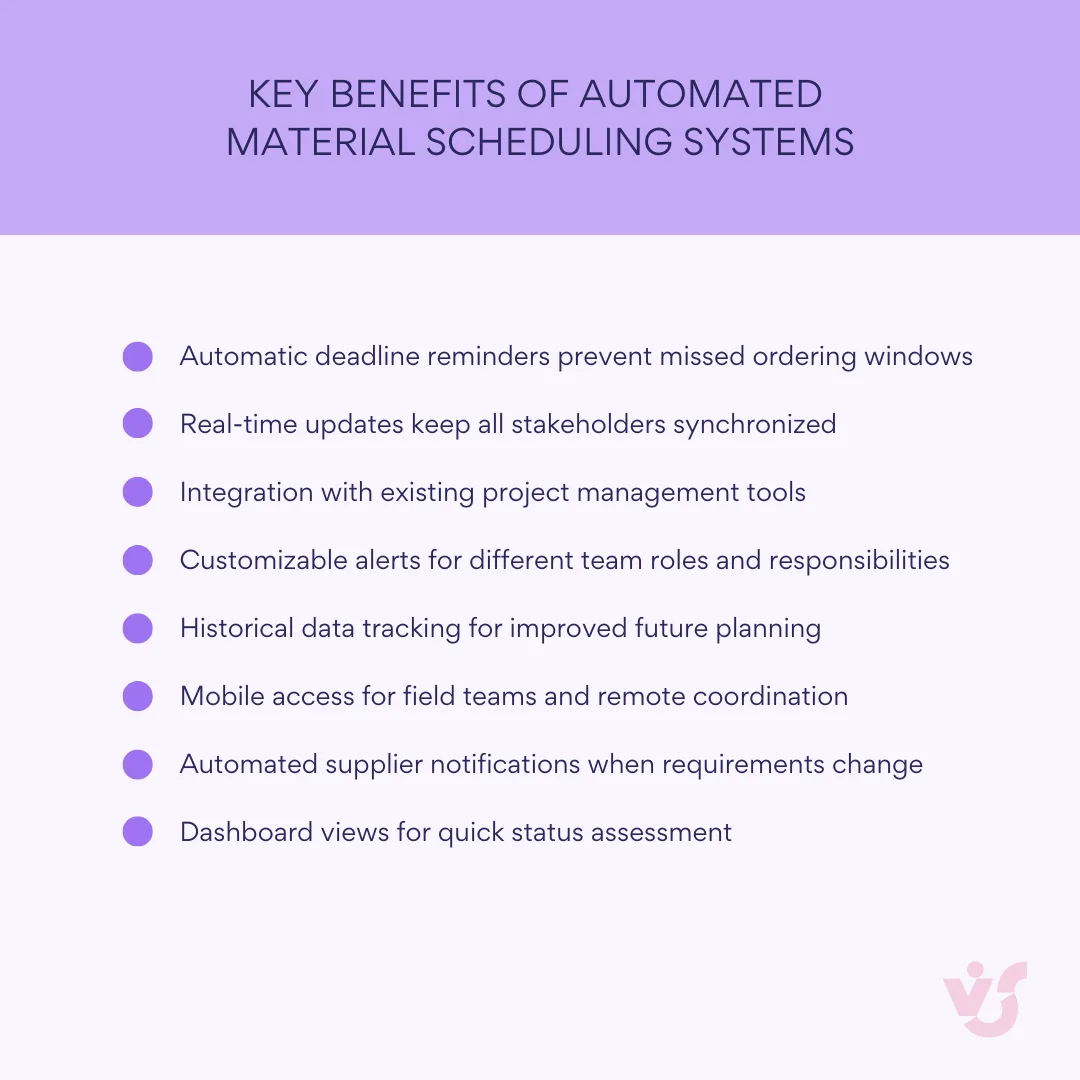
Template examples
Here are three practical templates designed for different industries and project types. Each template demonstrates how the core structure adapts to specific operational needs while maintaining the essential information required for effective material coordination.
Construction project template
| Project: Office Building Renovation | Stage: Foundation Work |
| Material name | Unit | Quantity | Delivery date | Use date | Supplier | Notes |
|---|---|---|---|---|---|---|
| Concrete M25 | m³ | 150 | 2025-07-15 | 2025-07-16 | BuildSupply Co. | Requires 24hr cure time |
| Steel rebar #4 | tons | 12 | 2025-07-14 | 2025-07-15 | MetalWorks Ltd | Store in dry area |
| Formwork panels | pcs | 200 | 2025-07-10 | 2025-07-15 | FormTech Inc | Return after use |
| Waterproofing membrane | m² | 800 | 2025-07-20 | 2025-07-22 | Seal Solutions | Temperature sensitive |
Status updates:
- Concrete delivery confirmed for 7:00 AM
- Rebar inspection scheduled for July 13
- Weather forecast clear for pour date
Manufacturing template
| Project: Appliance Production Line | Stage: Component Assembly |
| Material name | Unit | Quantity | Delivery date | Use date | Supplier | Notes |
| Motors 1200W | pcs | 500 | 2025-07-08 | 2025-07-10 | ElectroTech | QC testing required |
| Control panels | pcs | 500 | 2025-07-08 | 2025-07-12 | CircuitPro | Firmware v2.1 |
| Steel housings | pcs | 500 | 2025-07-05 | 2025-07-10 | MetalForm | Powder coated white |
| Wiring harnesses | sets | 500 | 2025-07-09 | 2025-07-14 | WireTech | Color coded |
Status Updates:
- Motor supplier requested delivery postponement to July 9
- Control panel firmware update completed
- Steel housing delivery confirmed on schedule
Logistics/Warehouse template
| Project: Holiday Season Inventory | Stage: Pre-Season Stocking |
| Material name | Unit | Quantity | Delivery date | Use date | Supplier | Notes |
| Gift boxes (small) | cases | 100 | 2025-11-01 | 2025-11-15 | PackagePro | Seasonal design |
| Shipping labels | rolls | 50 | 2025-10-25 | 2025-11-01 | LabelMax | Weather resistant |
| Bubble wrap | rolls | 200 | 2025-10-30 | 2025-11-15 | ProtectPack | 12″ width |
| Promotional inserts | pcs | 10,000 | 2025-11-05 | 2025-11-20 | PrintShop | Holiday theme |
Status Updates:
- Gift box samples approved by marketing team
- Shipping label printer maintenance scheduled for October 20
- Promotional insert artwork final approval pending
Tools and Methods for Material Scheduling
Choosing the right tools and methods for material scheduling depends heavily on your project scale, team size, and organizational complexity. This section explores the spectrum of available approaches, from simple Excel spreadsheets that work well for smaller projects to sophisticated enterprise systems that manage complex supply chains across multiple locations. We’ll examine the core scheduling methods that form the foundation of effective material planning, then dive into specific software solutions organized by category to help you identify the best fit for your particular needs.
Scheduling methods
Companies typically choose between simple solutions and complex systems based on their project scale, team size, and integration requirements. Understanding the main approaches helps you select the method that balances functionality with practicality for your specific situation.
Manual scheduling in Excel
Excel remains one of the most popular choices for material scheduling, especially among smaller teams and straightforward projects. This approach involves creating custom spreadsheets with formulas, conditional formatting, and basic automation features.
Advantages:
- Ease of use: Excel is available to virtually everyone and requires no specialized training to get started with basic scheduling functions
- Flexibility: You can easily adapt tables and formulas to match your specific project requirements, industry standards, or company processes
- Quick start: No need to purchase specialized software, set up complex systems, or develop elaborate structures from scratch
Disadvantages:
- Risk of errors: Manual data entry significantly increases the likelihood of typos, calculation mistakes, and data inconsistencies that can cascade through your entire schedule
- Limited automation capabilities: Excel lacks sophisticated features like automatic deadline reminders, real-time alerts, or seamless connections to procurement and logistics systems
- Poor scalability: When dealing with large amounts of data or coordinating multiple teams, it becomes increasingly difficult to maintain accuracy and track schedule relevance across all stakeholders
Using Gantt charts
Gantt charts provide visual representation of material delivery and usage timelines, making them particularly valuable for complex projects with interconnected dependencies. This method helps you see at a glance which material deliveries are tied to specific project stages and how delays in one area might affect other operations.
Gantt charts prove especially useful in projects with many parallel processes where you need to coordinate multiple material streams simultaneously. They excel at showing relationships between different deliveries and highlighting critical path dependencies that could impact overall project timing.
Popular platforms for Gantt-based material scheduling include Microsoft Project, Smartsheet, ClickUp, and similar project management systems that offer both scheduling capabilities and visual project tracking.
| Method | Best for | Advantages | Disadvantages | Setup time |
| Excel Spreadsheets | Small projects, 1-2 suppliers | Familiar interface, no software costs, highly customizable | Manual updates, version control issues, limited automation | 1-2 hours |
| Gantt Chart Tools | Projects with complex dependencies | Visual timeline, dependency tracking, resource allocation | Learning curve, can become complex, limited supplier integration | 4-8 hours |
| ERP Systems | Large organizations, multiple projects | Comprehensive integration, advanced reporting, enterprise security | High cost, complex implementation, requires training | 2-6 months |
| Specialized Calendar Apps | Teams needing collaboration, Microsoft users | Easy adoption, supplier collaboration, automated reminders | May lack advanced features, subscription costs | 1-2 days |
Integration with project management systems
Large companies often implement comprehensive project management systems that connect material scheduling with broader project coordination. These integrated approaches link material schedules directly with work calendars, resource allocation, and financial planning.
Popular enterprise-level systems include Microsoft Project for detailed project planning, Primavera P6 for large-scale construction and engineering projects, Monday.com for collaborative work management, and Asana or Wrike for team-based project coordination.
Key advantages of integrated systems:
- Automatic updates: When project deadlines change, material schedules automatically adjust to reflect new timing requirements
- Responsibility assignment: Clear accountability through automated task assignments and progress tracking
- Real-time reporting: Live dashboards and reports that show current status, upcoming deadlines, and potential issues before they become problems
Software solutions
Material scheduling software falls into several distinct categories, each designed to address specific operational needs and organizational structures. Understanding these categories helps you identify solutions that align with your industry requirements and technical infrastructure.
Construction management programs
Construction-focused platforms like Procore, Buildertrend, and PlanGrid (now part of Autodesk Build) offer comprehensive material management beyond simple scheduling. These systems integrate material planning with supply chain control, stakeholder communication, and document management workflows.
| Platform | Material scheduling features | Key strengths | Best for |
| Procore | Import schedules from MS Project/Primavera, calendar items for deliveries, daily logs integration | Comprehensive platform, mobile accessibility, robust integrations | General contractors, large construction projects |
| Buildertrend | Timeline creation, task assignments for deliveries, purchase order management | Construction-tailored, QuickBooks integration, color-coding | Home builders, remodelers, contractors |
| PlanGrid/Autodesk Build | Task creation for deliveries, document integration, field reporting | Strong document management, Autodesk ecosystem integration | Teams prioritizing document management |
These platforms prove particularly valuable for general contractors, project managers, and field teams who need comprehensive project oversight rather than just material scheduling functionality.
ERP systems
Enterprise Resource Planning systems like SAP, Oracle, and Microsoft Dynamics 365 provide the most robust material scheduling capabilities through integrated modules that connect procurement, logistics, warehousing, and production planning.
| Platform | Material scheduling features | Key strengths | Best for |
| SAP | MRP module, demand-based calculations, automated procurement proposals | Comprehensive supply chain integration, advanced optimization | Large manufacturing enterprises, complex supply chains |
| Oracle | Primavera P6 integration, material resource assignment, constraint-based optimization | Powerful scheduling engine, large project support | Construction and manufacturing, detailed resource management |
| Microsoft Dynamics 365 | Production planning, BOM-based scheduling, AI-enhanced forecasting | Microsoft ecosystem integration, scalable, user-friendly | Various industries, Microsoft-centric organizations |
These enterprise systems work best for large organizations that need material scheduling integrated with accounting, finance, and broader supply chain operations.
Specialized calendar solutions
Calendar-focused tools like Virto Calendar App, Teamup, and Zoho Calendar offer straightforward approaches to material scheduling through visual calendar interfaces that integrate well with existing workplace environments.
| Platform | Material scheduling features | Key strengths | Best for |
| Virto Calendar App | SharePoint/Office 365 events, Teams integration, customizable views | Microsoft ecosystem integration, easy to use | Microsoft-centric organizations, general scheduling |
| Teamup | Construction-specific material delivery scheduling, subcontractor access, multiple calendar views | Construction industry focus, customizable permissions | Construction teams, subcontractor coordination |
| Zoho Calendar | Event scheduling for deliveries, multi-level reminders, Zoho ecosystem integration | Free for basic use, integrates with Zoho CRM/Mail | Small teams using Zoho tools, personal scheduling |
These calendar solutions prove especially useful for small and medium-sized companies that value simplicity and clarity over complex feature sets.
Visualization tools
Visual project management tools like Trello, GanttPRO, and ClickUp organize materials by status and workflow stages rather than focusing primarily on scheduling dates. These platforms excel at showing material flow through different phases: ordered, in transit, delivered, and used.
| Platform | Material scheduling features | Key strengths | Best for |
| Trello | Kanban boards for material tracking, calendar view with due dates, power-ups for external integrations | Simple visual interface, free for basic use, widely accessible | General task management, simple material tracking |
| GanttPRO | Material resource assignment with costs, Gantt chart visualization, workload management | Visual Gantt charts, robust resource management | Project management with Gantt charts, construction/ production |
| ClickUp | Task scheduling for deliveries, calendar views, AI-driven automation | Highly customizable, extensive integrations, free tier available | General work management, customizable workflows |
These visualization tools work particularly well in cross-functional teams where different stakeholders need to understand material status quickly without diving into detailed scheduling data. The visual approach helps identify bottlenecks and delays that might not be apparent in traditional scheduling formats.
👉What is a material schedule in construction? A material schedule in construction is a detailed plan that specifies exactly what materials are needed, when they should be delivered, and in what quantities throughout a construction project. It coordinates the timing of deliveries with actual construction phases—ensuring concrete arrives on pour day, not a week early when it might spoil. The schedule includes critical information like supplier details, delivery dates, storage requirements, and usage timing to prevent costly delays and idle crews. It serves as the communication bridge between purchasing teams, suppliers, logistics coordinators, and on-site construction crews. Without proper material scheduling, construction projects frequently face work stoppages, budget overruns from emergency orders, and quality issues from last-minute material substitutions.
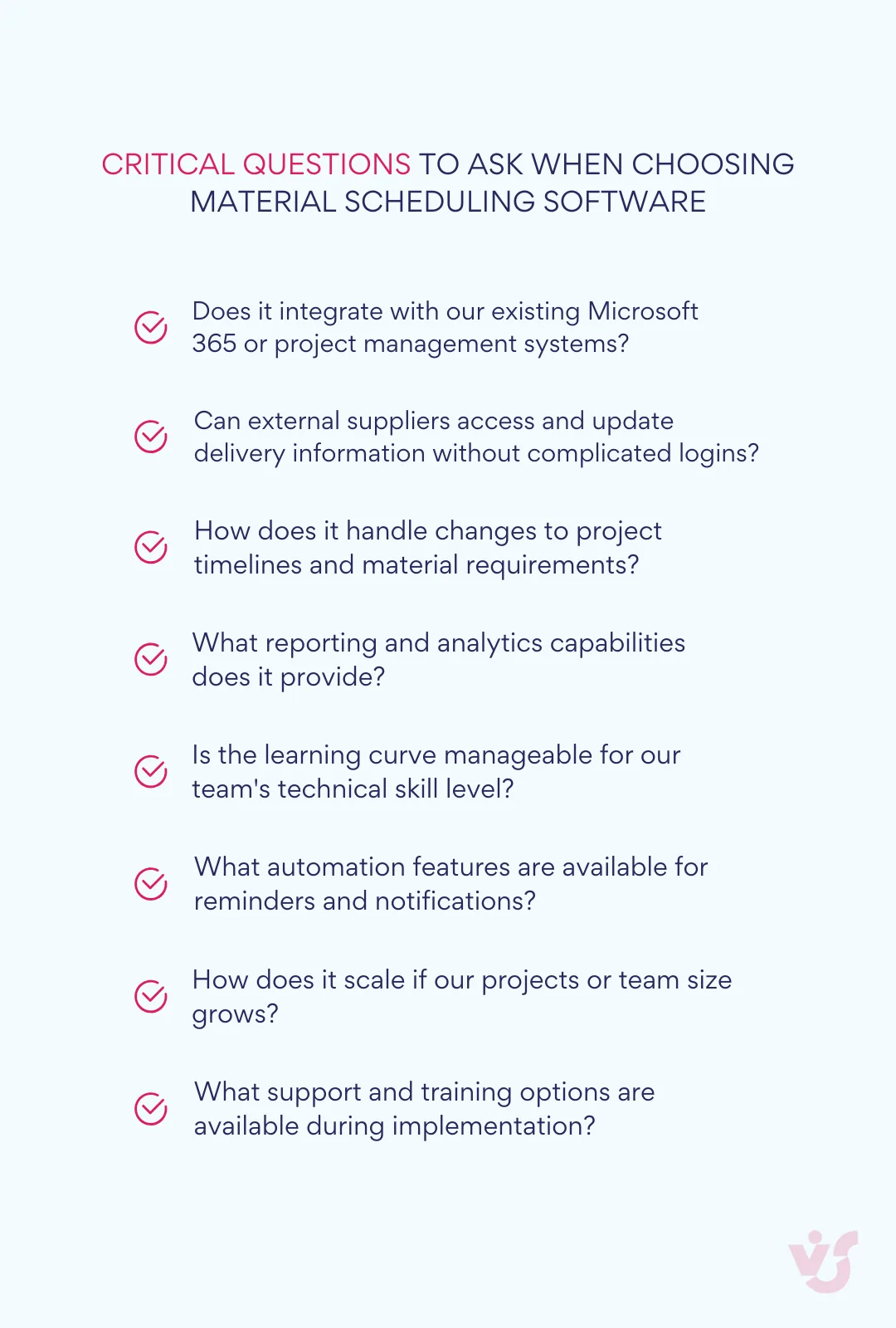
Monitoring the Delivery Schedule
Creating a material schedule is only the beginning—the real value comes from actively monitoring and maintaining it throughout your project lifecycle. This section explores how to keep your material plans current and actionable through systematic tracking, automated alerts, and integrated reporting systems. We’ll examine the key monitoring mechanisms that prevent schedules from becoming outdated documents, including deadline management, status reporting, accountability systems, and integration strategies that keep your material planning synchronized with broader project changes.
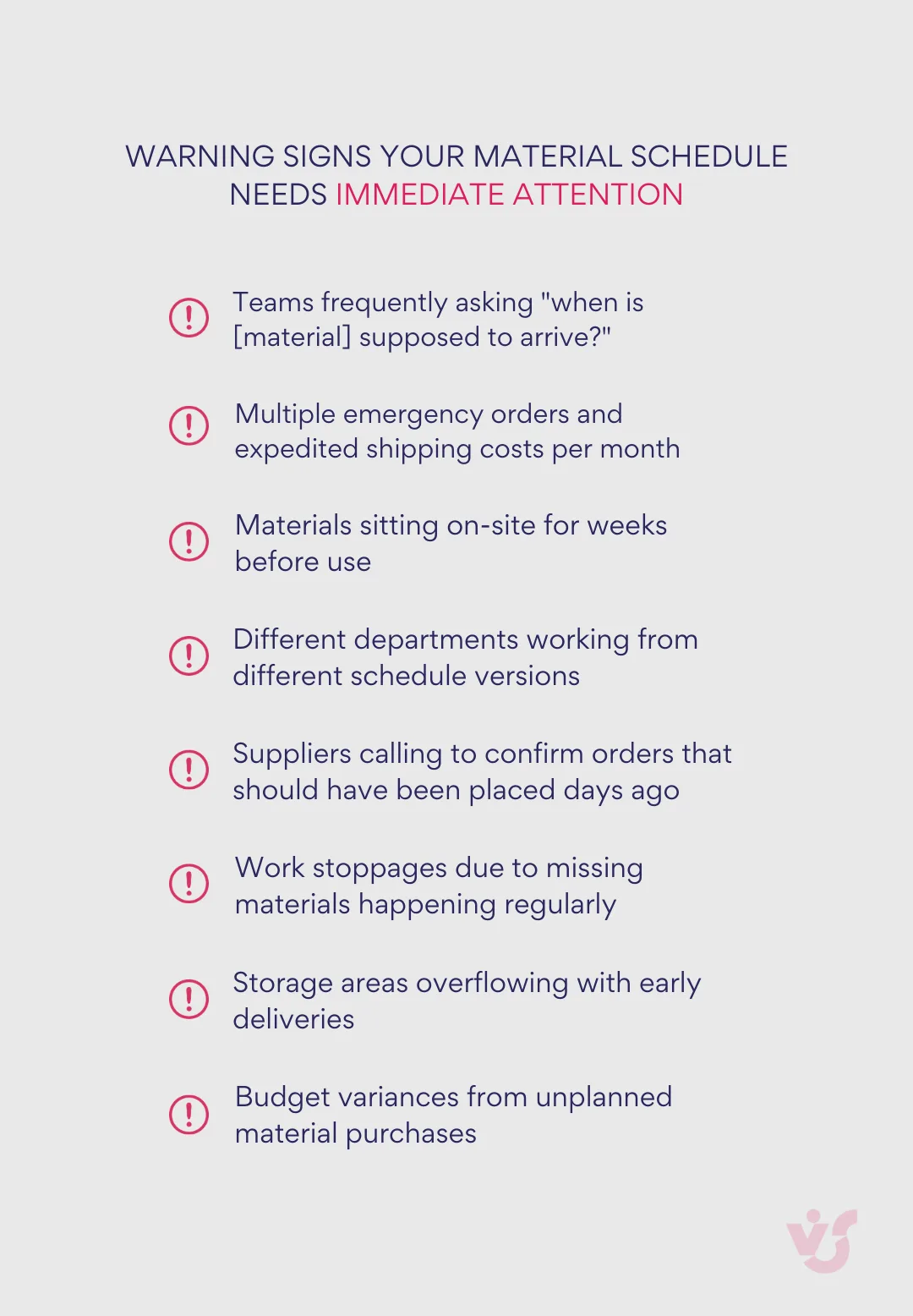
The critical need for continuous monitoring
Without constant monitoring, even the most carefully crafted material schedule quickly becomes irrelevant. Projects are dynamic environments where requirements shift, timelines change, and unexpected challenges arise. A schedule that accurately reflected your needs last month may be completely out of sync with current reality if it hasn’t been actively maintained.
Effective monitoring transforms your material schedule from a static planning document into a living management tool that guides daily decisions and helps prevent problems before they impact your project. This ongoing attention ensures your schedule remains aligned with actual project conditions and continues providing value throughout the entire project lifecycle.
Deadlines and automatic reminders
Modern material scheduling systems excel at proactive deadline management through automated notification systems that keep all stakeholders informed about upcoming requirements and potential issues.
These systems typically send notifications to responsible persons several days before critical deadlines, providing sufficient time to address potential problems. For example, if concrete is scheduled for delivery on Friday, the system might alert the project manager on Tuesday, giving time to confirm the delivery, check weather forecasts, and ensure the site is ready for the pour.
The advance warning significantly reduces the risk of delays by enabling early response to potential failures. Instead of discovering problems on the day materials should arrive, teams can identify and resolve issues while alternatives are still available. This proactive approach prevents the cascade of delays that often occurs when material shortages aren’t discovered until work stops.
Automatic reminders also help coordinate multiple stakeholders by ensuring suppliers, logistics teams, and field personnel all receive appropriate notifications. The supplier gets reminded to confirm shipment, the logistics coordinator receives notice to prepare receiving equipment, and the field team knows to expect the delivery.
Regular reports and status updates
Systematic reporting provides visibility into material schedule performance and helps identify patterns that might indicate systemic issues. Well-designed reporting systems generate actionable information rather than overwhelming stakeholders with unnecessary data.
Typical reports include “deliveries expected this week” summaries that help teams prepare for incoming materials, “delays more than 3 days” alerts that highlight items requiring immediate attention, and “delivery confirmation pending” lists that identify potential communication gaps with suppliers.
These reports prove valuable for different stakeholder groups. Suppliers can use weekly delivery reports to optimize their own logistics and prepare for upcoming shipments. Project managers benefit from delay reports that help them adjust work schedules and resource allocation. Logisticians use delivery forecasts to plan storage space, handling equipment, and site access coordination.
The key to effective reporting is customization—different stakeholders need different information at different frequencies. Field supervisors might need daily delivery confirmations, while executives prefer weekly summary reports showing overall schedule performance and significant delays.
Responsible performers and comments
Clear accountability prevents the “blurred responsibility” that often undermines material coordination efforts. Effective systems assign specific individuals to each material requirement, making it clear who should be contacted when issues arise and who is accountable for ensuring successful delivery.
This assignment goes beyond just naming a supplier—it includes identifying the specific person responsible for coordinating each delivery, the backup contact if the primary person is unavailable, and the internal team member who will verify receipt and quality upon arrival.
The ability to add comments or document reasons for delays directly within the system creates transparency and helps teams learn from problems. When a delivery is delayed, the responsible person can immediately update the system with the reason, expected new delivery date, and any actions being taken to minimize impact.
This documentation serves multiple purposes: it provides real-time communication to other stakeholders, creates a historical record for future reference, and helps identify recurring issues that might indicate the need for process improvements or supplier changes.
Comments also facilitate handoffs between team members. If the original coordinator becomes unavailable, the replacement can quickly understand the current status and any pending issues without starting from scratch.
Integration with other project modules
The most effective material scheduling systems integrate seamlessly with broader project management tools, ensuring material plans remain synchronized with overall project requirements as conditions change.
When construction stages shift due to weather delays, permit issues, or scope changes, integrated systems automatically adjust material delivery dates to match the new timeline. This prevents situations where materials arrive for work that has been postponed or where teams are ready to proceed but materials are still scheduled based on the original timeline.
Calendar synchronization connects material delivery dates with task schedules and milestone deadlines, providing a comprehensive view of project timing. Team members can see material deliveries alongside work assignments, making it easier to coordinate activities and identify potential conflicts.
Budget integration ensures material scheduling remains aligned with financial planning and cash flow requirements. When delivery dates change, the system can automatically update payment schedules and cash flow projections, helping maintain financial control throughout the project.
This integration extends to supplier communication systems, automatically notifying vendors when delivery requirements change and updating purchase orders to reflect new timing. Rather than relying on manual communication that might be delayed or missed, the system ensures all parties receive current information promptly.
The integrated approach also supports better decision-making by providing complete context for material-related choices. When evaluating options for addressing a delay, project managers can immediately see the impact on schedules, budgets, and other material requirements, enabling more informed decisions about the best path forward.
Common Mistakes in Creating and Managing Material Schedules
Even well-intentioned teams can undermine their material scheduling efforts through seemingly minor oversights that cascade into major project disruptions. This section examines the most frequent pitfalls that plague material scheduling across industries, from overly optimistic timeline assumptions to communication breakdowns between departments. Understanding these common mistakes—and their practical solutions—helps you build more resilient scheduling processes that account for real-world complexities and keep your projects moving forward even when things don’t go according to plan.
Not allowing for delays
In theoretical planning, deliveries arrive exactly on schedule. In reality, delays occur regularly due to production problems at supplier facilities, logistical failures during transportation, adverse weather conditions that prevent safe delivery, or customs procedures that take longer than expected for imported materials.
When schedules don’t include time buffers, any delay by even one supplier can stop entire projects or shift critical path activities. This creates a domino effect where one delayed delivery impacts multiple subsequent tasks, often with exponentially increasing consequences.
Real-world examples:
Construction scenario: Ordering concrete “just in time” for foundation pouring seems efficient, but if the concrete plant experiences equipment problems or the delivery truck encounters traffic delays, your entire construction crew sits idle. The cost of crew downtime often exceeds any savings from precise timing, and rescheduling concrete delivery may push the pour to the following week due to supplier availability.
Manufacturing scenario: An unaccounted delivery delay for imported electronic components can shut down an entire production line. If those components are scheduled to arrive the day production begins, any shipping delay, customs inspection, or quality control issue stops manufacturing until the materials arrive and pass inspection.
Solution: Include time buffers of 2-5 days for each key supplier, especially when deliveries depend on external factors beyond your direct control. Critical materials with long lead times or complex supply chains warrant larger buffers. Consider the supplier’s track record, transportation distance, and seasonal factors when determining appropriate buffer sizes.
Inconsistency between departments
Communication breakdowns between different project participants create some of the most frustrating and expensive material scheduling problems. These disconnects often occur at the handoff points between functional areas.
Specification mismatches frequently occur when designers specify one material type or grade, but purchasing departments source similar materials with different specifications to achieve cost savings or availability advantages. Production teams then receive materials that don’t meet their technical requirements, forcing costly substitutions or project delays while correct materials are sourced.
Timing inconsistencies create equally problematic situations. The purchasing department might issue delivery orders for dates when production isn’t ready to accept materials, resulting in expensive storage costs or site congestion. Alternatively, warehousing teams might not receive advance notice about large deliveries, leaving materials without appropriate storage space or handling equipment.
These problems multiply when teams work from different information sources or update schedules independently without coordinating changes across departments.
Solution: Establish a unified information environment where all process participants have real-time access to the current material schedule. Implement regular cross-departmental communication checkpoints and require approval from receiving departments before finalizing delivery dates. Use shared project management platforms that automatically notify relevant team members when schedule changes occur.
Using outdated data
Material schedules are living documents that must evolve continuously as project conditions change. Suppliers modify their capabilities and lead times, work scopes get revised based on field conditions or client requests, and project deadlines shift due to external factors or scope adjustments.
When teams rely on outdated schedule versions, serious problems emerge. Materials get ordered in incorrect quantities for work that has been modified or canceled. Delivery dates remain tied to original timelines even though project phases have shifted by weeks or months. Team members make decisions based on invalid information, creating coordination problems and resource conflicts.
The problem intensifies when different team members work from different schedule versions, creating conflicting expectations and communication confusion. A purchasing manager working from last month’s schedule might confirm deliveries for dates that no longer align with current project requirements.
Solution: Implement centralized schedule storage in cloud-based systems with automatic updates and change notifications. Establish version control procedures that prevent outdated schedules from circulating. Set up automatic alerts when schedules are updated so all stakeholders receive current information promptly. Consider implementing systems that prevent access to outdated versions rather than relying on users to remember to check for updates.
Lack of automated deadline control
Manual schedule maintenance makes it easy to lose track of approaching deadlines, especially in complex projects with hundreds of material requirements and multiple overlapping timelines. Critical ordering deadlines can slip by unnoticed until it’s too late to secure timely delivery.
This lack of systematic deadline monitoring creates several cascading problems. Materials don’t get ordered with sufficient lead time, forcing expensive expedited delivery charges or schedule delays while standard delivery options are pursued. Suppliers might not receive timely reminders about pending orders, causing procurement requests to sit idle in their systems without action. Most problematically, no one realizes urgent action is needed until delivery dates have already passed or materials are needed immediately.
Consequences of manual deadline tracking:
- Orders placed too late for standard delivery timelines
- Suppliers unaware of pending requirements until the last minute
- No early warning system for potential delays or problems
- Team members overwhelmed trying to track multiple deadlines simultaneously
Solution: Implement automated reminder systems that send notifications to responsible persons well before critical deadlines. Set up alert mechanisms that trigger when deliveries deviate from planned schedules or when supplier confirmations are overdue. Establish monitoring functions for “red zones”—critical deliveries that could impact project timelines if delayed.
Even minimal automation provides significant benefits. Calendar applications with notification features, including specialized tools like Virto Calendar App, can provide basic automated deadline tracking without requiring complex software implementations.
Insufficient schedule visualization
Large projects often involve hundreds of different materials with varying delivery schedules, supplier relationships, and criticality levels. Presenting this complex information solely in tabular format, such as Excel spreadsheets, makes it extremely difficult to quickly analyze situations and make informed decisions.
Problems with table-only presentations:
- Status confusion: It becomes difficult to understand which deliveries have been completed and which face potential delays without manually scanning through extensive lists
- Timeline misalignment: Comparing material delivery calendars with overall work schedules requires mental coordination between multiple documents or spreadsheet tabs
- Communication challenges: Explaining current situations to team members during planning meetings or client presentations becomes cumbersome and time-consuming
These visualization limitations become particularly problematic during crisis management situations where quick decisions are needed. When delivery problems arise, teams need to rapidly assess impact on other materials and project timelines, but tabular formats slow down this critical analysis.
Solution: Implement visual scheduling tools that provide immediate insight into schedule status and relationships. Use color coding to indicate different material statuses—green for confirmed deliveries, yellow for pending confirmations, red for delayed items. Deploy Gantt charts that show material deliveries alongside work schedules, making it easy to identify dependencies and potential conflicts.
Consider interactive calendar systems that allow filtering by materials, project stages, or suppliers, enabling users to focus on relevant information quickly. These visual controls become especially important in projects with multiple teams or distributed organizational structures, such as international supply chains where stakeholders in different locations need to understand schedule status without extensive explanation.
Visual scheduling tools also improve stakeholder communication by providing clear, intuitive representations of complex scheduling information that can be easily shared in meetings, reports, and client presentations.
Optimizing Material Schedule with VirtoSoftware Calendar Solutions
While general calendar tools can handle basic material scheduling needs, specialized solutions designed for Microsoft 365 environments offer enhanced functionality that transforms how teams coordinate material deliveries and project timelines. This section explores how VirtoSoftware’s calendar applications provide targeted features for material scheduling, from simple delivery tracking to complex multi-supplier coordination. We’ll examine how these tools address the specific challenges of material management while integrating seamlessly with existing Microsoft workflows that most organizations already use daily.
Virto Shared Calendar
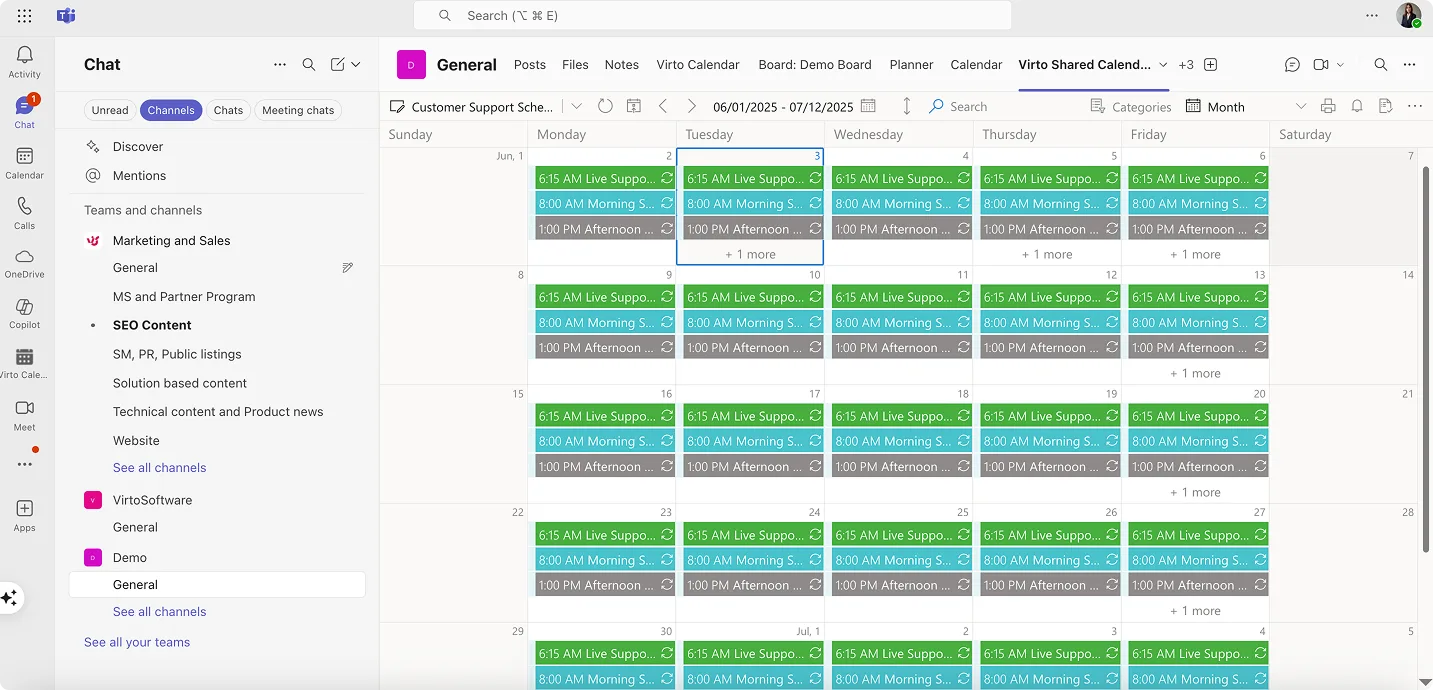
Virto Shared Calendar represents a streamlined approach to material scheduling, designed specifically for teams that need straightforward event management without complex overlay features. This lightweight solution focuses on essential scheduling functions while providing powerful sharing capabilities that eliminate common coordination barriers.
The app offers simplified event creation with color-coded tagging for clear material categorization—allowing teams to distinguish between different material types, suppliers, or delivery phases at a glance. Its standout feature is anonymous access, enabling seamless collaboration with external stakeholders like suppliers and vendors without requiring them to maintain Microsoft accounts or navigate complex authentication processes.
Available both within Microsoft Teams and as a standalone web application, Virto Shared Calendar ensures accessibility across devices and platforms while maintaining the simplicity that makes it ideal for teams prioritizing ease of use over advanced integration features.
Virto Calendar App
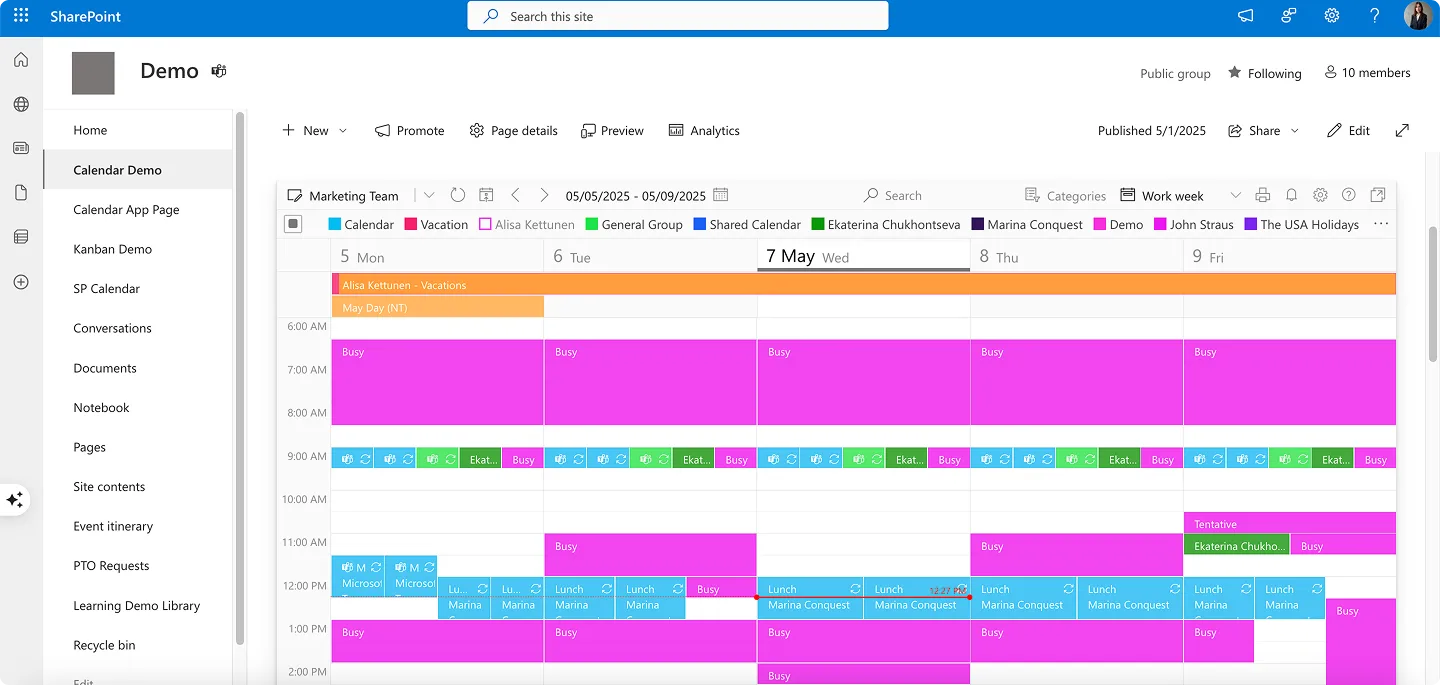
Virto Calendar App provides comprehensive calendar overlay functionality designed for complex material scheduling scenarios requiring integration across multiple data sources. This enterprise-focused solution serves as a central scheduling hub that consolidates information from SharePoint lists, Outlook calendars, external suppliers’ iCal feeds, and other calendar sources into unified views.
The app supports diverse data source integration, allowing teams to overlay material delivery schedules from suppliers’ systems with internal project timelines, warehouse availability calendars, and team schedules. This comprehensive integration creates a complete picture of material flow without requiring manual data consolidation across multiple systems.
With enterprise-grade security and Microsoft 365 native integration, Virto Calendar App provides the robust functionality needed for large-scale material coordination while maintaining the security standards required for business-critical operations.
Explore VirtoSoftware Calendar Solutions
How VirtoSoftware Calendar Apps Enhance Material Scheduling
Both VirtoSoftware calendar solutions offer specific features that address the unique challenges of material coordination, from basic delivery tracking to complex multi-supplier management. Here’s how these capabilities translate into practical material scheduling improvements:
Delivery date planning
Virto Calendar App excels at synchronizing material delivery dates across purchasing, logistics, and construction site teams through its comprehensive data source integration capabilities. By overlaying multiple calendar sources, it ensures all stakeholders work from the same timeline information. This synchronization becomes especially valuable for projects involving multiple suppliers or warehouse locations where coordination complexity increases exponentially.
The app enables centralized delivery date management where purchasing teams can input confirmed delivery dates from supplier systems, logistics coordinators can track shipment status through integrated calendars, and site teams can prepare for material receipt—all within unified calendar views. When delivery dates change in any connected system, automatic updates ensure all teams receive current information immediately.
Virto Shared Calendar provides straightforward delivery date planning through its color-coded event creation system, making it ideal for smaller teams or simpler coordination needs without the complexity of multiple data source integration.
Tracking critical dates
Virto Calendar App provides the most comprehensive tracking for all critical material lifecycle dates through its ability to integrate with multiple data sources: initial ordering deadlines from procurement systems, shipment confirmations from supplier calendars, expected receipt dates from logistics platforms, and planned usage timing from project management tools.
Both apps become particularly powerful when combined with Virto Alerts & Reminders app, which provides condition-based custom alerts. However, Virto Calendar App’s integration capabilities enable more sophisticated automated workflows, while Virto Shared Calendar offers simpler but effective critical date tracking through its event tagging system and notification features.
Supply chain visualization
Virto Calendar App’s overlay functionality provides the most sophisticated visual representation of complete material lifecycles by combining information from multiple systems into unified calendar views. This comprehensive visualization makes it easier to understand timing relationships across different suppliers and identify potential bottlenecks.
Virto Shared Calendar excels at simple, clear categorization through its streamlined tagging system—green for confirmed deliveries, yellow for shipments in transit, blue for materials in storage, and red for immediate usage requirements. Its strength lies in providing quick visual status assessment during planning meetings without the complexity of multiple system overlays.
Collaboration with teams
Virto Shared Calendar particularly excels in team collaboration through its anonymous access feature, allowing external suppliers and vendors to view and contribute to material scheduling without requiring Microsoft accounts. This eliminates authentication barriers that often complicate supplier coordination.
Virto Calendar App provides more sophisticated collaboration features through its integration with SharePoint and Microsoft 365 permissions, enabling detailed role-based access controls where different team members can view, edit, and comment on material scheduling events according to their specific responsibilities.
Microsoft ecosystem integration
Virto Calendar App offers the deepest Microsoft ecosystem integration, seamlessly connecting with SharePoint lists, Outlook calendars, Microsoft Teams, and other Microsoft 365 services. This comprehensive integration enables sophisticated workflow automation where material schedule changes can trigger notifications through Teams channels, update related SharePoint lists, and coordinate with Outlook calendar appointments.
Virto Shared Calendar provides focused integration with Microsoft Teams and operates as a standalone web app, making it ideal for organizations that want calendar functionality without the complexity of extensive system integrations. Its Teams integration allows embedding material scheduling directly into project channels while maintaining simplicity and accessibility.
Explore VirtoSoftware Use Cases
Conclusion on Materials Schedule
Material scheduling stands as one of the most critical tools for efficient resource management across construction, manufacturing, and logistics industries. As we’ve explored throughout this guide, the difference between project success and costly delays often comes down to how well you coordinate the flow of materials through your operations.
The importance of accurate material planning and control cannot be overstated—it’s your primary defense against downtime that stops progress and budget overruns that erode profitability. When materials arrive exactly when needed, in the right quantities, and in proper condition, your teams maintain momentum and your projects stay on track. When material coordination fails, the ripple effects touch every aspect of your operation.
This becomes especially true in complex projects involving multiple teams and suppliers, where scheduling transforms from a helpful planning tool into a key success factor that can make or break entire initiatives. The more moving parts your project involves—different suppliers, multiple delivery locations, various material types, distributed teams—the more critical systematic material scheduling becomes.
The traditional approaches of manual spreadsheets and basic calendar tools, while familiar, simply can’t handle the complexity and coordination demands of modern projects. This is where specialized solutions make the difference between struggling with material coordination and having it work seamlessly in the background.
- Virto Shared Calendar excels for teams that need straightforward, accessible material scheduling with powerful external collaboration features. Its anonymous access capabilities eliminate barriers with suppliers and vendors, while its streamlined interface keeps coordination simple and effective.
- Virto Calendar App provides comprehensive material scheduling for organizations requiring sophisticated integration across multiple systems and data sources. Its overlay functionality and deep Microsoft 365 integration make it ideal for complex projects where material coordination must work seamlessly with existing enterprise systems.
Both solutions address the core challenges we’ve discussed: preventing delays through automated reminders, avoiding departmental miscommunication through centralized scheduling, maintaining current information through real-time updates, and providing the visual clarity that transforms complex material flows into manageable, understandable processes.
Schedule a personalized demo to see how VirtoSoftware Calendar solutions can address your specific material scheduling challenges, or start with free trial versions available on our website to explore the features that will make the biggest impact on your projects.
Continue improving your project coordination skills with these additional resources from our blog:
- Microsoft Planner vs Project
- Project Gantt Chart
- Project Calendar Management
- Project Management Solutions
- Rooms & Resources Booking
Effective material scheduling isn’t just about avoiding problems—it’s about creating the foundation for project excellence. With the right tools and systematic approaches, you can transform material coordination from a source of stress into a competitive advantage that keeps your projects moving forward smoothly and profitably.

